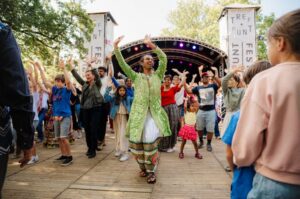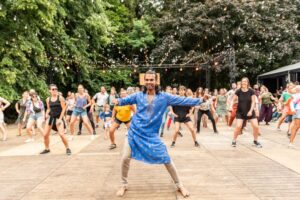BRIDGING CULTURES THROUGH GARBA

Garba, a traditional dance from Gujarat, India, celebrated during Navratri, is characterised by energetic, circular movements and rhythmic clapping. Recognised for its cultural significance, Garba is listed as Intangible Cultural Heritage by UNESCO. This designation highlights its role in fostering community spirit and preserving cultural traditions globally.
Swapnil Dagliya is an acclaimed dancer and artistic director based in Ghent, Belgium. Originally from Pune, India, he has extensive training in Bollywood, ballet, jazz, modern, and Indian folk dances, including Garba and Bhangra. His global journey includes stints at the Broadway Dance Center in New York and Opus Ballet in Italy. Since moving to Belgium in 2015, Dagliya has actively promoted Indian dance through Shoonya Dance Centre and the Gent India Dans Festival. He is known for his innovative teaching methods and dedication to bridging cultural gaps, fostering a vibrant appreciation for Indian dance in Europe. Excerpts from his interview:
Can you tell us about your dance training background?
My dance journey began in Pune, India, a city known for its vibrant Bollywood scene. I immersed myself in various dance styles, including ballet, jazz, modern, contemporary, and semi-classical dance, all while integrating traditional Indian dance forms. My initial training was deeply rooted in Bollywood, which provided a strong foundation in rhythm and expression. To further my expertise, I trained at prestigious institutions such as the Broadway Dance Center in New York and Opus Ballet in Italy. These experiences allowed me to refine my technique and broaden my stylistic repertoire. Additionally, I earned a diploma in Indian folk dance, mastering traditional forms like Garba, Bhangra, and Terah Taali. My academic journey included teaching roles at the University of Pune and Flame University, where I developed my pedagogical skills. Currently, I serve as the artistic director of Shoonya Dance Centre and ABC, a Bollywood Company in Ghent, Belgium. This role allows me to blend my diverse skills and passion for dance, leading both a local and international audience.
Could you share your journey of living in Belgium and promoting Indian folk art?
I moved to Belgium from Pune, India, in 2015, driven by a desire to explore dance opportunities in Europe. This transition was both challenging and fulfilling. Initially, I focused on introducing Bollywood dance to a Belgian audience, which laid the groundwork for further cultural exchange. Over time, I expanded my teaching to include various Indian folk dances, such as Bhangra and Garba, as well as semi-classical and Indian contemporary dance forms. This broader approach allowed me to reach a diverse audience and foster a deeper appreciation for Indian dance traditions. The response from the Belgian community has been overwhelmingly positive.
How challenging is it to promote an Indian dance in a foreign country
Promoting Indian dance in Belgium involves navigating cultural differences and making the art form accessible to a new audience. To address these challenges, I developed a specialized teaching methodology that adapts Indian dance forms to the local context. My experience as a teacher and professor has been instrumental in this process. A significant part of my strategy includes organizing the Gent India Dans Festival annually. This event plays a crucial role in introducing various Indian dance forms to a broader audience, creating a platform for cultural exchange. My ability to adapt Garba, in particular, has been a key factor in its success. By understanding and addressing the unique preferences and sensibilities of Belgian audiences, I have been able to create engaging and enjoyable experiences.
How do people in Belgium view Garba?
Garba has been warmly received in Belgium, where people appreciate its energetic movements and the sense of community it fosters. The dance’s communal spirit resonates with audiences, many of whom find similarities between Garba and their own folk dances performed in circles. This shared sense of celebration helps bridge cultural gaps and makes the dance more relatable. Additionally, the music associated with Garba has been particularly inspiring for Belgian audiences. Even if they don’t understand the lyrics, they can feel the devotion and emotion conveyed through the music.
Can you describe how the group Garba dance on the street in Belgium came about?
The group Garba dance was part of the Shoonya Indian Night at the Gentse Feesten, one of Europe’s largest and most renowned folk and music festivals. This festival runs for ten days and attracts a diverse audience. Since 2015, I have conducted dance workshops at this festival, which has become a key platform for sharing Indian dance traditions. When I was invited to organize an Indian Night as part of the festival, I chose to feature Garba due to its vibrant and inclusive nature. The event was a fantastic opportunity to showcase Garba to a larger audience, creating a lively and communal experience. The enthusiastic participation and positive feedback from festival-goers highlighted the growing interest in Indian dance forms in Belgium.
Where did you learn Garba and how do you celebrate in in Belgium?
My journey with Garba began at a young age through attending Navratri events in India. These events provided a strong foundation in Garba and exposed me to its traditional forms. I also took classes with various Garba teachers, which further enriched my understanding and technique. This foundational training was complemented by my experiences with other folk dances, allowing me to develop a unique perspective on Garba. At Shoonya Dance Centre, we organize an annual Navratri Garba & Dandiya Night, which has become a highlight of our cultural calendar since 2021. This event attracts a diverse group of participants, including Belgians, my students, and many from the Indian diaspora. It’s a vibrant celebration that includes traditional Garba and Dandiya dancing, along with a communal meal. I take great pride in cooking for around 250 people and dancing with the attendees. This event is not only a celebration of Garba but also a testament to the cultural exchange and community spirit that we have fostered here in Belgium.
Photo Courtesy by Stijn Dejonckheere
Sandip Soparrkar holds a doctorate in world mythology folklore from Pacific University USA, an honorary doctorate in performing arts from the National American University, He is a World Book Record holder, a well-known Ballroom dancer and a Bollywood choreographer who has been honored with three National Excellence awards, one National Achievement Award and Dada Saheb Phalke award by the Government of India. He can be contacted on sandipsoparrkar06@gmail.com







